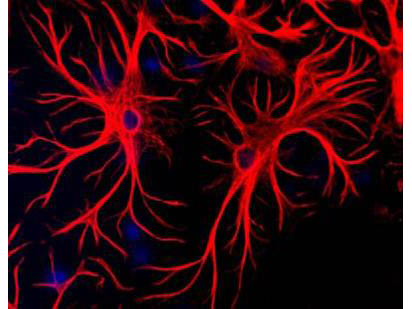Ras belongs to the family of small G-proteins and plays an important role in several signal transduction pathways involved in normal cell growth and differentiation. Over 30 years ago three isoforms of Ras – H-Ras, N-Ras, and K-Ras, have been identified for their oncogenic activation in human cancer cells. In fact aberrant Ras signaling could be shown in more than 30% of all human cancers including lung, colon, and pancreatic cancer. K-Ras has been identified as the most important Ras protein in cancer research.
As other small G proteins, Ras cycles between inactive (GDP-bound) and active state (GTP-bound) forms (see figure).
Although extensive research activities have been dedicated to Ras, no effective Ras inhibitor has been identified so far. But, there may be new hope in developing a therapeutic inhibitor to Ras proteins by targeting the upstream guanine nucleotide exchange factor (GEF) protein SOS (Son of sevenless).
Cytoskeleton Inc. has put together recent findings and concepts in the pursuit of identifying viable drug targets to control atypical Ras signaling.
This information can be found in their recent newsletter: New small molecule inhibitors to control Ras signaling via Sos/K-Ras binding.
To investigate the activation of Ras and the role of the SOS protein, new research tools are now available:
#1 – Ras G-LISA Activation Assay Kit
#2 – Ras Activation Assay – pull-down format
It’s interesting to explore the differences between the G-LISA® and the pull-down format of small G protein activation assays, and the benefits of the G-LISA technology as demonstrated here.
#3 – Rho GEF Exchange Assay Kit
The fluorophore based assay in this kit is can be used to measure nucleotide exchange on GTPases in either 96-well or 384-well format. The kit measures the uptake of the fluorescent nucleotide analog N-methylanthraniloyl-GTP (mant-GTP) into GTPases.
#4 – Raf Human GST Beads
The Ras binding domain (RBD) of the c-Raf kinase protein (Raf) protein has been expressed as a GST-fusion protein in E. coli. This protein binds specifically to GTP-bound, and not GDP-bound, Ras proteins. The protein comes in a glutathione agarose bound format.
#5 – Human SOS1 Protein (Exchange Domain 564-1049)
Human SOS1 is an exchange factor for the small G-protein Ras. The biological activity of SOS1 can be determined from its ability to catalyze the exchange of GDP for GTP on Ras. A standard biological assay for monitoring the catalytic activity of hSOS1 is an exchange assay utilizing the 2x Exchange Buffer from the Rho-GEF exchange assay kit. Human SOS1 Protein is available on request, if you interested in knowing more, just get in touch via the form below.
If you’re interested in exploring new solutions for your Ras related research projects, tebu-bio’s experts will be pleased to talk to you.
[contact-form to=’Ali.el.baya@tebu-bio.com’ subject=’Please contact me for further information about Ras related research tools’][contact-field label=’Name’ type=’name’ required=’1’/][contact-field label=’Email’ type=’email’ required=’1’/][contact-field label=’Comment’ type=’textarea’ required=’1’/][/contact-form]




